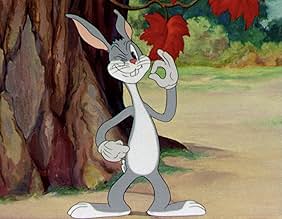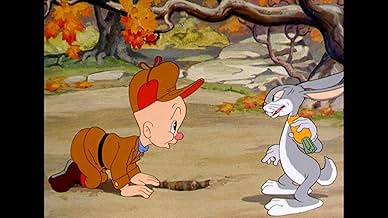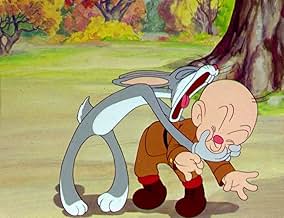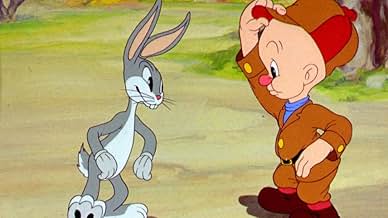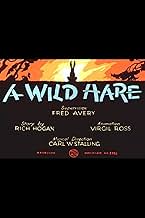VALUTAZIONE IMDb
7,7/10
2060
LA TUA VALUTAZIONE
Aggiungi una trama nella tua linguaWhile hunting rabbits, Elmer Fudd comes across Bugs Bunny, who tricks and harasses the hunter.While hunting rabbits, Elmer Fudd comes across Bugs Bunny, who tricks and harasses the hunter.While hunting rabbits, Elmer Fudd comes across Bugs Bunny, who tricks and harasses the hunter.
- Regia
- Sceneggiatura
- Star
- Candidato a 1 Oscar
- 2 candidature totali
Mel Blanc
- Bugs Bunny
- (voce)
- (non citato nei titoli originali)
- …
Arthur Q. Bryan
- Elmer Fudd
- (voce)
- (non citato nei titoli originali)
Recensioni in evidenza
Rabbits were common in early animation such as in Walt Disney's 'Oswald the Rabbit.' But the king of all cartoon rabbits is Bugs Bunny. His first official appearance was in July 1940 "A Wild Hare,' co-starring Elmer Fudd as the hunter entrapped by Bugs Bunny's clever antics.
The Merrie Melody cartoon, drawn by the wizard artists at Leon Schlesinger Productions, was part of Warner Brothers distribution arm. The studio had introduced an earlier incarnation of Bugs in 1938's "Porky's Hare Hunt' featuring a frustrated Porky the Pig trying to shoot a clever and elusive rabbit. Four cartoons later of the pesky rabbit Bugs appeared in "A Wild Hare," directed by Tex Avery. Voice actor Mel Blanc employed his Bronx/Brooklyn accent to mimic the rabbit modern viewers are familiar. This is the first cartoon Bugs uses his catchphrase, "What's up, Doc?" Director Tex Avery claims he's the one who came up with the phrase from his days living in Texas where it was a commonly said. Mel Blanc, however, said he first ad-libbed the saying spontaneously in the narration booth, and everyone loved it.
Animator Bob Givens was assigned to redesign the previous rabbits into the basic look we see today as Bugs Bunny. Givens lengthened the rabbit's body, and has him standing straight up. There were a couple of attributes as to the origins on Bugs' habit chomping on carrots. One is the famous scene in 1934's Academy Award Best Picture winner "It Happened One Night" where Clark Gable munches on a carrot while Claudette Colbert exhibits her method of hitchhiking. Another is wise-cracking actor Roscoe Karns' character Oscar Shapely in the same movie, who was a big carrot fan.
Bugs Bunny appeared in over 160 cartoons between 1940 and 1964, and has been in more films than any other animated character. Bugs has a star on Hollywood's Walk of Fame and is Warner Brothers' official mascot.
The Merrie Melody cartoon, drawn by the wizard artists at Leon Schlesinger Productions, was part of Warner Brothers distribution arm. The studio had introduced an earlier incarnation of Bugs in 1938's "Porky's Hare Hunt' featuring a frustrated Porky the Pig trying to shoot a clever and elusive rabbit. Four cartoons later of the pesky rabbit Bugs appeared in "A Wild Hare," directed by Tex Avery. Voice actor Mel Blanc employed his Bronx/Brooklyn accent to mimic the rabbit modern viewers are familiar. This is the first cartoon Bugs uses his catchphrase, "What's up, Doc?" Director Tex Avery claims he's the one who came up with the phrase from his days living in Texas where it was a commonly said. Mel Blanc, however, said he first ad-libbed the saying spontaneously in the narration booth, and everyone loved it.
Animator Bob Givens was assigned to redesign the previous rabbits into the basic look we see today as Bugs Bunny. Givens lengthened the rabbit's body, and has him standing straight up. There were a couple of attributes as to the origins on Bugs' habit chomping on carrots. One is the famous scene in 1934's Academy Award Best Picture winner "It Happened One Night" where Clark Gable munches on a carrot while Claudette Colbert exhibits her method of hitchhiking. Another is wise-cracking actor Roscoe Karns' character Oscar Shapely in the same movie, who was a big carrot fan.
Bugs Bunny appeared in over 160 cartoons between 1940 and 1964, and has been in more films than any other animated character. Bugs has a star on Hollywood's Walk of Fame and is Warner Brothers' official mascot.
Elmer and Bugs finally collide for real this time for the first time ever, in an excellent short by the late, great Tex Avery that hints of things to come. Elmer of course is hunting rabbits, Bugs(unnamed when this came out, although we all know it's him now) is of course defending himself, foiling Elmer's plans and driving him crazy. This is one of the two's best(why wasn't this on the Looney Tunes DVD? Oh well, guess I can wait for a Silver collection). I recommend seeing it to any fan of the "wabbit," or the hunter. After seeing how little has actually changed between the two, it's easy to realize that some things really do never change.
BOTTOM LINE: The first, and one of the best, Bugs vs. Elmer shorts.
BOTTOM LINE: The first, and one of the best, Bugs vs. Elmer shorts.
Compared to the first (two) appearances of the developing Bugs, this is very funny, has characters with incredibly developed plots and indeed is better quality. I find because the humour of "Porky's Hare Hunt" and "Prest-O Change-O" are very old-fashioned and not very understandable for today's humour (although I still found "Porky's Hare Hunt" quite funny). This episode feels much more like it was made recently, even though it was made only two or three years after the developing Bug's first appearances. In this, apart from his deeper voice, he feels much more like the Bugs Bunny we know today.
I also like this episode for the very sweet first Elmer featured, Bugs Bunny is very entertaining and there is nice animation included. I have to say in this, Bugs Bunny reminded me a lot of Br'er Rabbit, which was comforting (HE didn't make his first appearance for nearly ten years after!!).
The plot is very much like the average episode with Elmer and Bugs. Elmer is hunting for "wabbits" and he finds Bugs. Many of the gags have been repeated many times in more recent episodes, but are still funny none the less. There are some other gags added which are funny.
I recommend this episode to enthusiasts of early Looney Tunes (but still like gags which are repeated in modern Looney Tunes episodes) and who like Bugs Bunny. Enjoy "A Wild Hare"!
I also like this episode for the very sweet first Elmer featured, Bugs Bunny is very entertaining and there is nice animation included. I have to say in this, Bugs Bunny reminded me a lot of Br'er Rabbit, which was comforting (HE didn't make his first appearance for nearly ten years after!!).
The plot is very much like the average episode with Elmer and Bugs. Elmer is hunting for "wabbits" and he finds Bugs. Many of the gags have been repeated many times in more recent episodes, but are still funny none the less. There are some other gags added which are funny.
I recommend this episode to enthusiasts of early Looney Tunes (but still like gags which are repeated in modern Looney Tunes episodes) and who like Bugs Bunny. Enjoy "A Wild Hare"!
A Wild Hare (1940)
*** 1/2 (out of 4)
This is where it all started as the dimwitted Elmer Fudd travels to the woods hunting rabbit and comes across Bugs Bunny who is just too smart. A WILD HARE was actually the third film that Bugs appeared in but this here is the official first as the rabbit we all love. It's funny watching this first short because what's here is what we'd see for the next several decades as Bugs was just so appealing and he was often put up against rather dumb characters. There are several very funny moments here but the highlight has to be poor Elmer not realizing that while his digging for the rabbit that he's actually sitting there talking to him. Another highlight is the scene where Bugs pretends to die just so he can pull one more prank.
*** 1/2 (out of 4)
This is where it all started as the dimwitted Elmer Fudd travels to the woods hunting rabbit and comes across Bugs Bunny who is just too smart. A WILD HARE was actually the third film that Bugs appeared in but this here is the official first as the rabbit we all love. It's funny watching this first short because what's here is what we'd see for the next several decades as Bugs was just so appealing and he was often put up against rather dumb characters. There are several very funny moments here but the highlight has to be poor Elmer not realizing that while his digging for the rabbit that he's actually sitting there talking to him. Another highlight is the scene where Bugs pretends to die just so he can pull one more prank.
Here is Tex Avery's magnificent film in which we are first introduced to a brownish-gray colored hare named Bugs, although we really don't hear his name spoken in this film. Yet that immortal phrase, "What's Up Doc???" is here, and Bugs is a sly, bold, incredibly smart woodland creature outfoxing that "wovable" hunter, Elmer Fudd. No more wacky prototypes. Bugs is at last fleshed out the way he should be. I appreciate his "Dad" and "Grandpa" very much. Someone's dream wouldn't have come true without them and our star might never have been born without them. Nevertheless, the star is Bugs Bunny!!! And after this film, he was well on his way to becoming what he is today.
Thank you Tex Avery!!!
Thank you Tex Avery!!!
Lo sapevi?
- QuizThe producers' reaction to the gag of Bugs responding to a hunter pointing a gun at him with a confident casual remark, "What's up, Doc?" was so favorable that they decided to make that a standard element of future films featuring the character.
- BlooperAfter Bugs ties up Elmer's shotgun and Elmer throws it away he then starts digging. Bugs comes up from his other hole, saying his first time ever "Eh Whats up Doc?" then Elmer says "I am looking for a Wabbit". Bugs starts describing a rabbit and during a close up When Elmer realized Bugs is a rabbit he us holding the shotgun again, next panel it's gone again.
- Citazioni
[first lines]
Elmer Fudd: [first occurence of this line] Be vewy, vewy qwiet. I'm hunting wabbits.
- Curiosità sui creditiIn the 1944 Blue Ribbon reissue of this cartoon, when the WB shield zooms in the copyright notice briefly says MCMXLIV(1944) for a fraction of a second before changing to MCMXL(1940)!
- Versioni alternativeWhen the cartoon was re-released as a Blue Ribbon re-issue, it was inadvertently retitled "The Wild Hare." Also, one of the names Elmer Fudd guesses was changed from Carole Lombard, who had recently died in a plane crash, to Barbara Stanwyck.
- ConnessioniEdited into Bugs Bunny Superstar (1975)
- Colonne sonoreYankee Doodle
(ca. 1755) (uncredited)
Traditional music of English origin
I più visti
Accedi per valutare e creare un elenco di titoli salvati per ottenere consigli personalizzati
Dettagli
- Data di uscita
- Paese di origine
- Sito ufficiale
- Lingua
- Celebre anche come
- Conigli e carote
- Azienda produttrice
- Vedi altri crediti dell’azienda su IMDbPro
- Tempo di esecuzione
- 8min
- Mix di suoni
- Proporzioni
- 1.37 : 1
Contribuisci a questa pagina
Suggerisci una modifica o aggiungi i contenuti mancanti

